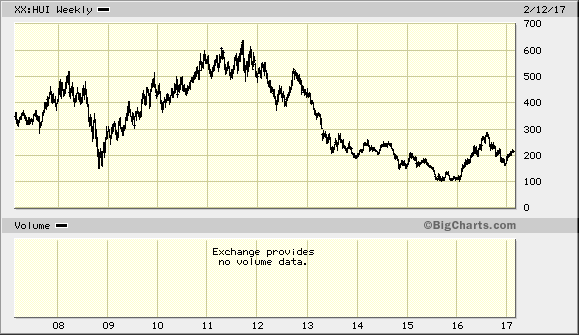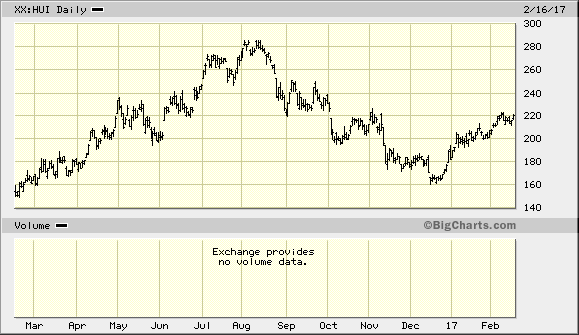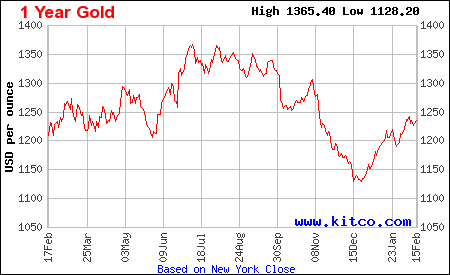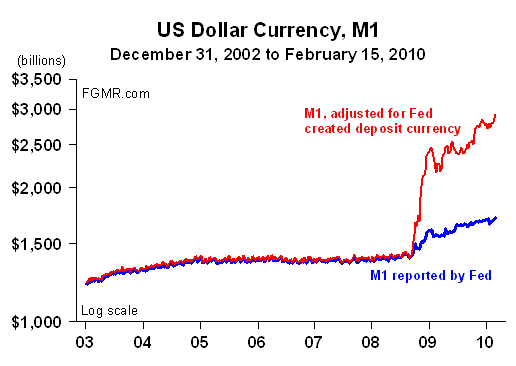Are you wondering when is the best time to take the plunge and buy gold stocks? Is 2017 going to continue to build on the gold trends that began in 2016? We believe it will be another strong year for gold, and especially strong for gold stocks. Now is the perfect time for investors to take a position and load up on the precious metal.
Before we explain why gold stocks are ripe picks in 2017, let’s first define why people invest in gold at all (be aware, there is a definite Western-centric flavor to my argument).
Why Investors Buy Gold
So, why do investors invest in gold? Why should YOU invest in gold? The reality is that gold investors buy or sell gold for a couple of major reasons. First, you have to understand that gold is money. It has been for thousands of years, long before any fiat currency existed. And while many fiat currencies have come and gone, gold has continued to endure.
Gold is Money. How?
Money has 4 primary functions:
Medium of Exchange
Store of Value
Unit of Account
Standard of Deferred Payment
Gold has a long-established track record of fulfilling all four functions, which is why gold has endured as a form of money for thousands of years. Gold has a record that is unparalleled by any fiat currency.
As a medium of exchange, gold is used widely around the globe to purchase goods and services. Only a few fiat currencies carry the same universal acceptance as physical gold. Even in a remote part of the world, with a few Krugerrand in your pocket you can find food and a place to sleep.
Perhaps the most impressive characteristic of gold is its record as a store of value. Fiat currencies have a history of failures, where gold has been the model of stability. It is that consistency and stability that investors crave from gold, and they crave it in the form of value.
Any asset that can be;
saved;
retrieved, and;
exchanged with predictability
thus demonstrates a store of value.
Gold has held its value better than any other asset in history; nothing has even come close, which is why investors consider gold a safe haven currency or a type of ‘tonic for inflation’.
But value is meaningless, without it being able to reconciled or measured. Just as each US Dollar is identical to every other US Dollar when it comes to a market transaction, so is each 1oz, 24-carat coin. That is how money acts as a unit of account.
Finally, gold is used like money to settle a debt or is a standard of deferred payment.
Safe-Haven Currency
Investors concerned about instability in the market, or who are looking for a hedge against inflation, often turn to gold. Since gold is physical, not electronic or printed, there are limits to the growth of its supply, which works to keep its value stable. If every homeowner could dig gold out of their basement when they needed it, the value of the metal would rapidly depreciate, but since the worldwide supply of gold only increases by a relatively constant 1.5 to 2 per cent each year from mining, it maintains its value through relative scarcity.
So gold is both rare enough that it cannot suddenly flood the market, and plentiful enough to make it viable as form of currency. For the same reasons, gold is practically inflation-proof.
Inflation occurs when there are too many dollars chasing too few goods. Whereas a country’s central bank can print or withhold Dollars, Euros, Pounds, or Yuan at will, gold can only come from a mine. Again, only 1.5 to 2 per cent of new gold supply enters the market each year. This limited, predictable supply creates the track record that gold boasts and is the reason that investors trust it as a counter-measure to inflation.
Gold is Money- Not a Commodity,
Not Digital, Not Paper, No Yield
Gold is:
Money, it can be used like other forms of currency,
Not a commodity, like copper, it has no applicable utility other than as money,
Not digital, it can’t be hacked or manufactured online,
Not paper money, you can’t print it like paper money,
Doesn’t produce a yield, income, rent or dividend.
To many, this last point is a failing of gold but, again, gold is not an investment product, gold is money. A dollar won’t produce a yield either — until it’s invested in the market.
The Geopolitical Environment
United States
The American Dollar represents the biggest single influence in the demand for gold. In general, when the US economy is strong and stable, demand (and thus the unit price) for gold drops off. If the US economy is (or is even perceived as) uncertain or failing, gold becomes more attractive.
For that reason, I focus much of my attention on the recent change in the US administration. The election of Donald Trump has created an investment environment suitable for gold. There is a new President in the United States, and he has made no qualms about his plans to rebuke the status quo. In the long term, Mr. Trump’s path may be a winning strategy, but only time will tell. In the meantime, his political volatility makes harbouring in gold a sound strategy: if confidence in his American leadership stutters, gold’s value goes up. If on the other hand Trump makes good on his “Make America Great” theme, demand for gold is still unlikely to drop much, if at all.
Short-term, President Trump’s “road less traveled” is likely to cause friction, both domestically and internationally. Above all else, gold is a safe-haven currency that thrives during global instability. A big factor in 2017 will be The Donald; there is no denying his influence on the world stage.
On the surface, the President doesn’t appear to mind disruption if it furthers his agenda. To be blunt, he appears to employ disruption as a tactic. This strategy worked domestically to rally his electoral support, and his presidential agenda is clear – put US interests at the forefront – but on the global stage, that agenda and his tactics risk fostering an environment of unease and instability.
The Superpower nation is currently engaged in;
Conflicts in the Middle East,
Trade disputes with Mexico,
Pulling out of the Trans-Pacific Partnership,
A reinvigorated cold war with Russia,
An unstable leader in North Korea, and
An expansionary China in the South China Sea.
Mr. Trump will have to learn on the job, as the geopolitical environment looks poised for conflict.
Manufacturing Sector
It will be interesting to see President Trump’s plan to reinvigorate the U.S. manufacturing market. Constructing a wall along the Mexican border is only partially to protect the country from the “bad hombres” (criminals, gang members, drug dealers, and terrorists) who featured in his election rallying cry. The other stated purpose of the wall is to keep undocumented Mexican labor from entering the US — the fear being that illegal immigrants take employment opportunities away from legal citizens.
Trump was successful at tapping into Labor’s growing frustration with the dwindling manufacturing sector. His first step is to keep illegal workers out of the country. Next, he needs to convince existing companies not to outsource manufacturing jobs to cheaper labor markets. Conceivably, some combination of the ‘carrot and the stick’ is needed to facilitate this move. The obvious route would be tax-based incentives (which have already been promised) combined with punitive import tariffs.
One problem facing the US manufacturing sector is the strength of their ‘almighty dollar.’ Trump has already stated he is not happy with competing nations pursuing currency devaluation. He has acknowledged the US Dollar is already likely too strong. A strong dollar makes jobs more expensive. Labour costs directly affect the cost of production, making goods more expensive.
As job creation is a major reason that voters elected Donald Trump, it stands to reason that it is a focal point for his presidency.
Infrastructure Spending
One of the key points of Trump’s platform is a trillion-dollar infrastructure initiative. Infrastructure spending is a great way to stimulate jobs and the economy, and in the long term it will increase the competitiveness of the US in attracting manufacturing jobs. The proposed plan will be spread over the next 10 years and will focus on rebuilding inner cities, bridges, tunnels, schools, highways and hospitals.
The question is, who will pay for this ambitious plan?
With plans to reduce corporate and income tax rates, can the funds come from public coffers? Or will the government look to another round of quantitative easing?
Europe
The European Union faces numerous challenges in 2017, all of which will impact global markets. The first hurdle it must clear is the process set in place to complete Great Britain’s exit from the EU. Last year’s historical vote in the United Kingdom to leave the EU sent gold soaring.
The UK and EU will now decide if the withdrawal will be delayed or immediate. That decision that will further impact the price of precious metals.
But that is not the only concern facing the EU this year, as three major European nations will hold federal elections in 2017. Germany, France, and the Netherlands will all go to the polls in 2017. And all three nations have seen a rise in anti-EU sentiments over the past several years.
If France votes to leave – a real possibility – it could influence German voters later in the year. The prospect of no UK, no France, and no Germany means there would be in essence, no economic union. Whatever happens, 2017 promises to test the unity of the E.U. It is an environment that is ripe with unease and investors are always looking for ways to hedge risk.
Mexico
Mexico is facing a whole new era of relations with the US, and by all accounts this new era will lack the cozy relationship of previous years. The Mexican peso plummeted with The Donald’s election last year, and the US has already begun deporting thousands of illegal immigrants back to Mexico.
President Trump made public his intent to renegotiate NAFTA, specifically targeting Mexico with such things as his plans to construct a 1,900-mile wall along the US-Mexico Border and a proposed 20-per-cent tax on imported Mexican goods to pay for the border wall. In January, the Ford Motor Company canceled plans to construct a new plant in Mexico.
Mexico is facing some difficult decisions with regards to their largest trading partner.
What appears certain is the North American Free Trade Agreement (NAFTA) is facing revision. How much depends on if the three parties (Canada being the third) can come to an agreement. While Mexico has been a target of the US President, Canada has seemed to avoid much of his ire. Canada and the US engaged in over $575 billion of trade in 2015 and little of that was due to an outsourcing of labor. Mexico, on the other hand, represents a cheap labor market, and it is that fact that concerns the US.
Protectionism, Mercantilism & Inflation
As we noted previously, inflation occurs when too much money is chasing too few goods. On the face of it, Trump’s three central planks are all inflationary:
Infrastructure spending increases both the money supply and the national employment rate – high demand for consumer goods and lots of money available for those goods drives prices up and the value of the dollar down. If Quantitative Easing (printing more money) is used to pay for the infrastructure, the effect is multiplied;
Walls (tariff or otherwise) between trading partners effectively limit the amount of goods available to consumers, driving up prices and;
A US-first environment (low corporate taxes, Buy-America policies and limiting the foreign worker pool) will further drive wages and prices up while limiting supply.
So why the fear of inflation? Put simply, every inflationary percentage point devalues the dollar and shrinks the absolute worth of your investments. As an investor, gold exposure is an excellent method to offset potential inflation. In an inflationary environment, the urgency for gold exposure increases dramatically.
Why Gold Stocks?
First, we are not suggesting foregoing physical gold. But we do feel that gold stocks represent a huge opportunity for investors.
Take a look at the 10-year chart for the NYSE Arca HUI Gold Bugs Index.
The HUI is a dollar weighted index that contains a basket of unhedged gold stocks.

As you can see, gold stocks trended upwards late 2008. This corresponded with QE1, buying up more than $600 billion in mortgage back securities.
The index peaked between 2011 and 2012, as the US dollar began to strengthen.
Gold Stocks were locked in a bear market until beginning to showing life in 2016.
Although the HUI indicates a correction in the second half of 2016, it rallied in early 2017. The rally corresponds with the Trump administration taking the reigns of power.

The interesting thing to keep in mind is to contrast with the 1-year price of gold (as seen below). The chart tracks the HUI Index, but with more volatility.
While higher volatility represents higher risk, it also means greater opportunity.
 The opportunity for investors is illustrated by the two charts above. e.
The opportunity for investors is illustrated by the two charts above. e.
The HUI Gold Bugs Index had a saw a +90% difference between the 52 week low ($149.17) and the 52 week high ($286.05).
Contrast that with the fact that the price of gold fluctuated in that same period from a low of $ to a high of $. That is a difference of %.
It is this point we emphasize, as gold stocks represent an opportunity for investors in 2017.
Trump’s administration has acknowledged a strong greenback is a hurdle to rebuilding US manufacturing. Gold and the US dollar have historically maintained a strong inverse relationship.
A strong dollar imparts a sense of pride and is a positive economic indicator. It also presents a problem for US exporters of ‘made in US’ goods, it makes them expensive.
As we discussed earlier, the HUI trends upward with the Fed buying mortgage back securities. This is a direct response to the US decision to increase their money supply.
Renowned investor James Turk points out the unreported increases to the M1 money supply. He shows an adjusted M1 chart, that includes the Federal Reserve Created Deposit Currency.
A prominent Federal Reserve critic, Peter Schiff projects the return of Quantitative Easing.
Schiff targets Trump’s campaign promise to reduce corporate and personal income tax. Besides those tax cuts, there is Trump’s trillion dollar infrastructure project. He points out that there is no viable option here, except more rounds of Quantitative Easing.
“We’re going to have to do even more quantitative easing (QE),” said Schiff, explaining that the central bank will have to return to its most potent weapon: Super-easy liquidity to pump-prime the economy. (source:CNBC)

